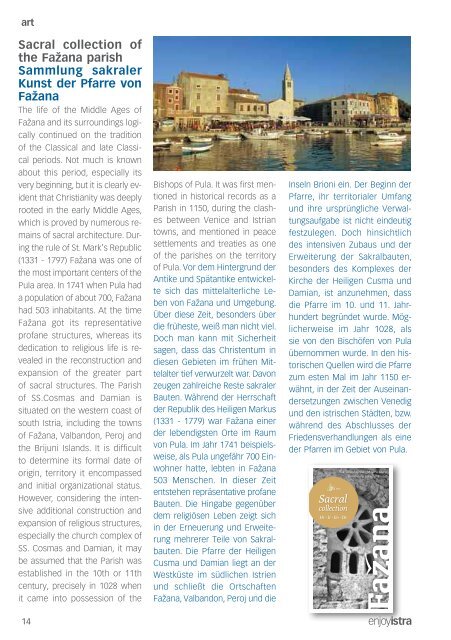enjoyistra
PDF downloaden - Porec
PDF downloaden - Porec
- No tags were found...
Create successful ePaper yourself
Turn your PDF publications into a flip-book with our unique Google optimized e-Paper software.
art<br />
art<br />
Sacral collection of<br />
the Fažana parish<br />
Sammlung sakraler<br />
Kunst der Pfarre von<br />
Fažana<br />
The life of the Middle Ages of<br />
Fažana and its surroundings logically<br />
continued on the tradition<br />
of the Classical and late Classical<br />
periods. Not much is known<br />
about this period, especially its<br />
very beginning, but it is clearly evident<br />
that Christianity was deeply<br />
rooted in the early Middle Ages,<br />
which is proved by numerous remains<br />
of sacral architecture. During<br />
the rule of St. Mark’s Republic<br />
(1331 - 1797) Fažana was one of<br />
the most important centers of the<br />
Pula area. In 1741 when Pula had<br />
a population of about 700, Fažana<br />
had 503 inhabitants. At the time<br />
Fažana got its representative<br />
profane structures, whereas its<br />
dedication to religious life is revealed<br />
in the reconstruction and<br />
expansion of the greater part<br />
of sacral structures. The Parish<br />
of SS.Cosmas and Damian is<br />
situated on the western coast of<br />
south Istria, including the towns<br />
of Fažana, Valbandon, Peroj and<br />
the Brijuni Islands. It is difficult<br />
to determine its formal date of<br />
origin, territory it encompassed<br />
and initial organizational status.<br />
However, considering the intensive<br />
additional construction and<br />
expansion of religious structures,<br />
especially the church complex of<br />
SS. Cosmas and Damian, it may<br />
be assumed that the Parish was<br />
established in the 10th or 11th<br />
century, precisely in 1028 when<br />
it came into possession of the<br />
Bishops of Pula. It was first mentioned<br />
in historical records as a<br />
Parish in 1150, during the clashes<br />
between Venice and Istrian<br />
towns, and mentioned in peace<br />
settlements and treaties as one<br />
of the parishes on the territory<br />
of Pula. Vor dem Hintergrund der<br />
Antike und Spätantike entwickelte<br />
sich das mittelalterliche Leben<br />
von Fažana und Umgebung.<br />
Über diese Zeit, besonders über<br />
die früheste, weiß man nicht viel.<br />
Doch man kann mit Sicherheit<br />
sagen, dass das Christentum in<br />
diesen Gebieten im frühen Mittelalter<br />
tief verwurzelt war. Davon<br />
zeugen zahlreiche Reste sakraler<br />
Bauten. Während der Herrschaft<br />
der Republik des Heiligen Markus<br />
(1331 - 1779) war Fažana einer<br />
der lebendigsten Orte im Raum<br />
von Pula. Im Jahr 1741 beispielsweise,<br />
als Pula ungefähr 700 Einwohner<br />
hatte, lebten in Fažana<br />
503 Menschen. In dieser Zeit<br />
entstehen repräsentative profane<br />
Bauten. Die Hingabe gegenüber<br />
dem religiösen Leben zeigt sich<br />
in der Erneuerung und Erweiterung<br />
mehrerer Teile von Sakralbauten.<br />
Die Pfarre der Heiligen<br />
Cusma und Damian liegt an der<br />
Westküste im südlichen Istrien<br />
und schließt die Ortschaften<br />
Fažana, Valbandon, Peroj und die<br />
Inseln Brioni ein. Der Beginn der<br />
Pfarre, ihr territorialer Umfang<br />
und ihre ursprüngliche Verwaltungsaufgabe<br />
ist nicht eindeutig<br />
festzulegen. Doch hinsichtlich<br />
des intensiven Zubaus und der<br />
Erweiterung der Sakralbauten,<br />
besonders des Komplexes der<br />
Kirche der Heiligen Cusma und<br />
Damian, ist anzunehmen, dass<br />
die Pfarre im 10. und 11. Jahrhundert<br />
begründet wurde. Möglicherweise<br />
im Jahr 1028, als<br />
sie von den Bischöfen von Pula<br />
übernommen wurde. In den historischen<br />
Quellen wird die Pfarre<br />
zum esten Mal im Jahr 1150 erwähnt,<br />
in der Zeit der Auseinandersetzungen<br />
zwischen Venedig<br />
und den istrischen Städten, bzw.<br />
während des Abschlusses der<br />
Friedensverhandlungen als eine<br />
der Pfarren im Gebiet von Pula.<br />
Sacral<br />
collection<br />
Hr · It · En · De<br />
Sakralna baština · Mostra sacra<br />
Sammlung sakraler Kunst<br />
The Old Romanesque<br />
Gate Das alte romanische<br />
Tor Vrsar-Orsera<br />
Compared to the main medieval<br />
town gate situated on the eastern<br />
part of Vrsar, this gate is smaller,<br />
therefore it is called the small town<br />
gate. The gate was built in the second<br />
half of the 13th century, when<br />
the Romanesque style was prevailing<br />
in Istrian towns. The gate frame<br />
consisting of thirteen stone blocks<br />
was carved out very precisely. In<br />
the past the gate used to be part<br />
of the town walls. Two gate wings<br />
made of hard Istrian oak have been<br />
preserved till the present days. Especially<br />
interesting are the stone<br />
rings that hold the wings. The gate<br />
is provided with a closing mechanism.<br />
Above it there is a fragment<br />
of the town walls and a stone tile<br />
with shallow relief representing St.<br />
Mark’s lion. As to its artistic characteristics,<br />
the lion resembles the<br />
one above the east gate and is<br />
probably made by the same artist.<br />
This lion also holds a closed book<br />
in his paws, has raised wings and<br />
lowered tail. The relief was made<br />
between the 14th and 16th century.<br />
Most likely it was brought from<br />
somewhere else and put above the<br />
gate about 1778 when the Venetian<br />
Republic became the ruler of Vrsar.<br />
There are two iron bawls built in the<br />
wall just by the gate. Those probably<br />
originate from the English ships<br />
which cannoned Istrian towns at<br />
the beginning of the 19th century,<br />
at that time under occupation of<br />
Napoleon’s soldiers.<br />
Im Vergleich mit dem Hauptstadttor<br />
aus dem Mittelalter auf der Ostseite<br />
Vrsar ist dieses Tor kleiner und<br />
wird das kleine Stadttor genannt.<br />
Das Tor wurde in der zweiten Hälfte<br />
des 12. oder Anfang des 13. Jh.<br />
gebaut, damals wurde in istrischen<br />
Städtchen im romanischen Stil<br />
gebaut und gemeißelt. Das Tor ist<br />
aus dreizehn Steinblöcken ziemlich<br />
präzise gemeißelt. Das Tor war ein<br />
Teil der Stadtmauern. Bis heute ist<br />
der Torflügel aus hartem istrischen<br />
Eichenholz erhalten geblieben. Interessant<br />
sind auch die steinernen<br />
Ringe, die zur Befestigung der Torflügel<br />
dienten. Die Torflügel haben<br />
auch eine Schlissvorrichtung. Über<br />
dem Tor ist ein Fragment der Stadtmauer<br />
und eine Platte mit flachem<br />
Relief des Löwen vom Hl. Markus<br />
angebracht. Künstlerisch ähnelt<br />
der Löwe dem am Osttor der Stadt<br />
und stammt wahrscheinlich von<br />
demselben Künstler. Wie der Löwe<br />
am Osttor hat auch dieser in den<br />
Pfoten ein geschlossenes Buch,<br />
ausgebreitete Flügel und angezogenen<br />
Schwanz. Der Löwe entstand<br />
in der Zeit zwischen dem 14. und<br />
dem 16. Jh. wahrscheinlich wurde<br />
er nach Vrsar gebracht und im Jahre<br />
1778 über dem Tor angebracht,<br />
als die Republik Venedig über Vrsar<br />
herrschte. Neben dem Tor sind zwei<br />
Kanonenkugeln eingemauert, die<br />
wahrscheinlich von den englischen<br />
Schiffen stammen, die am Anfang<br />
des 19. Jh. die Städtchen Istriens,<br />
die damals unter der Herrschaft<br />
Napoleons waren, bombardierten.<br />
infomust<br />
Ex tempore<br />
26. - 29.09.<br />
Grožnjan-Grisignana<br />
Ex tempore is a cultural<br />
event that takes place<br />
every year during the last<br />
week of September, attracting<br />
artists and art lovers<br />
from around the world<br />
Ex tempore ist eine kulturelle<br />
Veranstaltung, die<br />
jedes Jahr in der letzten<br />
Septemberwoche stattfindet<br />
und Künstler und Kunstliebhaber<br />
aus der ganzen<br />
Welt nach Grožnjan anzieht<br />
14 15




